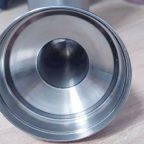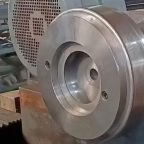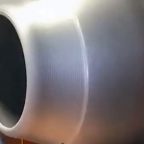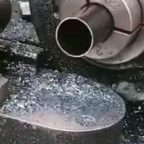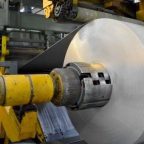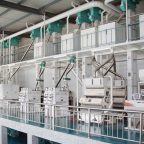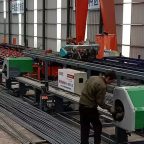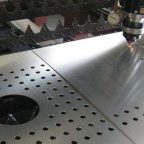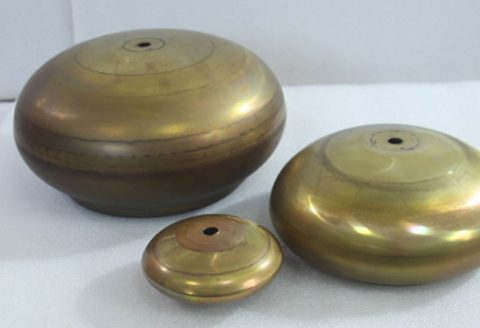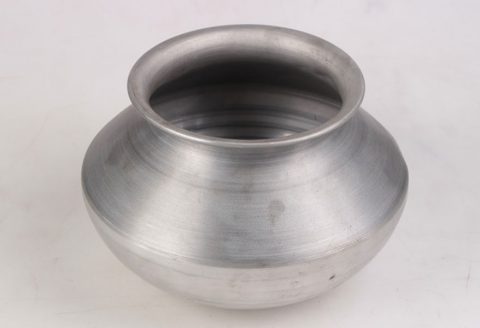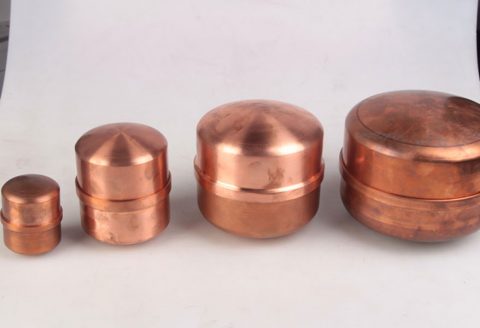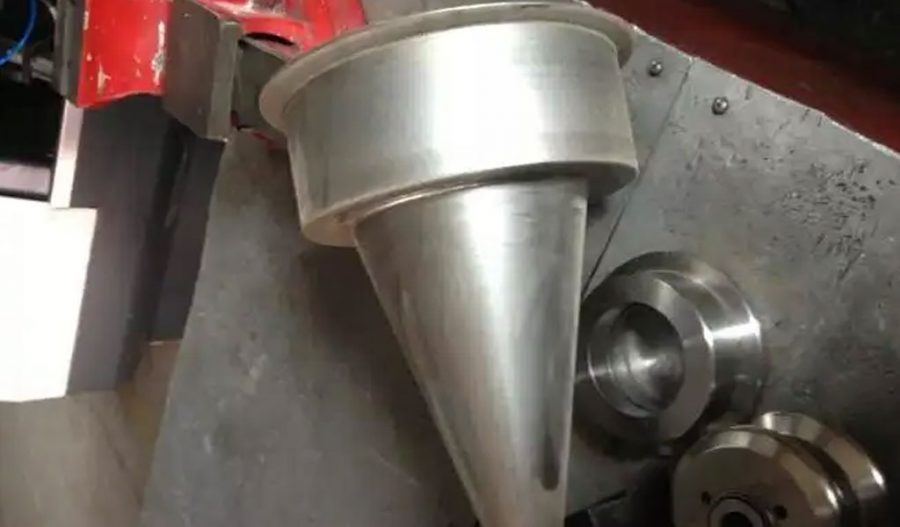
Metal spinning, a versatile manufacturing process, involves the shaping of sheet metal into axisymmetric components through localized plastic deformation. This technique, widely used in industries such as aerospace, automotive, and medical device manufacturing, relies on the controlled application of force to deform a rotating metal blank over a mandrel. The mechanical properties of the resulting components, particularly their strength, are profoundly influenced by the microstructure of the material, with grain boundaries playing a pivotal role. Grain boundaries, the interfaces between crystalline grains in polycrystalline metals, are critical microstructural features that govern deformation mechanisms, including grain boundary slip (GBS). GBS refers to the relative sliding of adjacent grains along their boundaries under applied stress, a phenomenon that becomes particularly significant at elevated temperatures or in fine-grained materials. This article explores the intricate relationship between grain boundary slip and material strength in the context of metal spinning, delving into the underlying mechanisms, influencing factors, and practical implications. Through a comprehensive analysis, supported by detailed tables comparing recent research findings, this work aims to provide a thorough understanding of how GBS affects the mechanical performance of spun metal components.
Fundamentals of Metal Spinning
Metal spinning, also known as spin forming, is a cold or hot forming process that transforms a flat metal blank into a hollow, rotationally symmetric shape. The blank, typically a circular sheet of metal, is clamped against a rotating mandrel and deformed using a roller or tool that applies localized pressure. The process can be categorized into conventional spinning, shear spinning, and flow forming, each distinguished by the degree of thickness reduction and deformation mechanics. Conventional spinning maintains the blank’s thickness, while shear spinning and flow forming reduce it, inducing significant plastic strain. The choice of process influences the extent of microstructural changes, including those at grain boundaries, which in turn affect the material’s strength.
Materials Used in Metal Spinning
Common materials for metal spinning include aluminum, stainless steel, titanium, copper, and their alloys, selected for their ductility, formability, and strength. These metals are typically polycrystalline, meaning their microstructure consists of numerous grains separated by grain boundaries. The grain size, shape, and boundary characteristics (e.g., misorientation, coherence) vary depending on the material’s composition, processing history, and heat treatment. For instance, aluminum alloys often exhibit fine grains due to rapid solidification, while stainless steels may have coarser grains unless subjected to grain refinement techniques. These microstructural features directly influence the propensity for GBS and the resulting mechanical properties of the spun component.
Deformation Mechanisms in Metal Spinning
During metal spinning, the material undergoes complex deformation involving tensile, compressive, and shear stresses. The primary deformation mechanisms include:
- Dislocation Slip: The movement of dislocations within grains, which dominates at room temperature and in coarse-grained materials.
- Grain Boundary Sliding (GBS): The relative motion of grains along their boundaries, more pronounced at elevated temperatures or in fine-grained materials.
- Twinning: The formation of twin boundaries, particularly in face-centered cubic (FCC) metals with low stacking fault energy, such as copper.
- Dynamic Recrystallization: The formation of new grains during deformation, often observed in hot spinning or in materials with high strain rates.
GBS, in particular, becomes a significant contributor to deformation when the grain size is small or when spinning is performed at temperatures above approximately 0.4 times the material’s melting point (homologous temperature). Understanding how GBS interacts with other deformation mechanisms is crucial for predicting the strength of spun components.
Grain Boundaries in Polycrystalline Metals
Definition and Structure
A grain boundary is the interface between two adjacent grains in a polycrystalline material, characterized by a mismatch in crystallographic orientation. Grain boundaries are two-dimensional defects that disrupt the perfect crystalline lattice, leading to regions of higher energy and disorder compared to the grain interior. They can be classified based on their misorientation angle:
- Low-Angle Grain Boundaries (LAGBs): Misorientation less than 15°, often composed of arrays of dislocations.
- High-Angle Grain Boundaries (HAGBs): Misorientation greater than 15°, with a more disordered atomic structure.
- Special Boundaries: Boundaries with specific crystallographic relationships, such as Σ3 twin boundaries in FCC metals, which exhibit lower energy and unique properties.
The structure of grain boundaries influences their ability to accommodate GBS, with HAGBs typically being more prone to sliding due to their disordered nature.
Role of Grain Boundaries in Mechanical Properties
Grain boundaries significantly affect the mechanical properties of metals, including strength, ductility, and toughness. According to the Hall-Petch relationship, the yield strength of a material increases with decreasing grain size due to the increased density of grain boundaries, which act as barriers to dislocation motion. The relationship is expressed as:
[ \sigma_y = \sigma_0 + k d^{-1/2} ]
where (\sigma_y) is the yield strength, (\sigma_0) is the friction stress, (k) is a constant, and (d) is the average grain diameter. However, in fine-grained materials, GBS can counteract this strengthening effect by facilitating deformation, potentially reducing strength under certain conditions.
Grain boundaries also influence fracture toughness, fatigue resistance, and creep behavior. For instance, they are preferred sites for crack initiation and propagation, particularly in brittle materials or under cyclic loading. In metal spinning, the interaction between grain boundaries and deformation mechanisms like GBS determines the final mechanical properties of the component.
Types of Grain Boundary Sliding
GBS can occur through two primary mechanisms, as described by the following:
- Rachinger Sliding: The grains slide relative to each other without significant change in shape, leading to an increase in the number of grains along the stress direction. This mechanism is associated with superplastic deformation and is common in fine-grained materials at high temperatures.
- Lifshitz Sliding: The sliding is accommodated by diffusion, resulting in grain elongation and a contribution to creep deformation. This mechanism is prevalent in diffusion creep processes, such as Nabarro-Herring or Coble creep.
Both types of GBS are relevant in metal spinning, particularly when performed at elevated temperatures or with fine-grained materials, as they influence the material’s ability to deform plastically and its resulting strength.
Grain Boundary Slip in Metal Spinning
Mechanisms of Grain Boundary Slip
In metal spinning, GBS occurs when the applied shear stress at the grain boundary exceeds the boundary’s resistance to sliding. This process is facilitated by the following factors:
- Temperature: Elevated temperatures reduce the activation energy for atomic diffusion, promoting GBS. In hot spinning, temperatures often exceed 0.4 times the material’s melting point, making GBS a dominant deformation mechanism.
- Grain Size: Smaller grains increase the grain boundary area per unit volume, enhancing the contribution of GBS to overall deformation. This is particularly relevant in nanocrystalline or ultrafine-grained materials.
- Boundary Character: HAGBs and non-coherent boundaries are more susceptible to GBS due to their disordered structure, while coherent boundaries, such as Σ3 twin boundaries, resist sliding.
- Stress State: The complex stress state in metal spinning, involving shear and compressive components, promotes GBS, especially in regions of high strain.
GBS is often accompanied by other mechanisms, such as dislocation slip and diffusion, which accommodate the sliding process and prevent the formation of voids or cracks at the grain boundaries.
Interaction with Dislocation Slip
The interplay between GBS and dislocation slip is critical in determining the material’s strength during metal spinning. Dislocations moving within a grain encounter grain boundaries, where they may:
- Pile Up: Accumulate at the boundary, creating a stress concentration that can trigger GBS or dislocation transmission to the adjacent grain.
- Transmit: Cross the boundary into the neighboring grain, requiring sufficient energy to overcome the boundary’s resistance.
- Absorb: Be absorbed into the boundary, contributing to its disorder and potentially facilitating GBS.
- Emit: New dislocations may be emitted from the boundary, accommodating further deformation.
The balance between these interactions depends on the grain boundary character, misorientation, and the applied stress. For instance, coherent twin boundaries in FCC metals like copper may allow dislocation transmission with minimal resistance, while random HAGBs promote GBS, reducing the material’s strength.
Influence of Processing Parameters
The extent of GBS in metal spinning is influenced by several processing parameters, including:
- Spinning Temperature: Higher temperatures enhance GBS by increasing atomic mobility and reducing the energy barrier for sliding. For example, spinning aluminum alloys at 300–400°C significantly increases GBS compared to room-temperature spinning.
- Strain Rate: Lower strain rates favor GBS by allowing more time for diffusion and boundary sliding. In contrast, high strain rates promote dislocation slip and suppress GBS.
- Tool Path and Force: The roller’s path and applied force determine the stress distribution, affecting the regions where GBS is most likely to occur. Complex tool paths may induce localized GBS in areas of high shear stress.
- Material Pre-treatment: Pre-treatments such as annealing or severe plastic deformation (e.g., equal-channel angular pressing) can refine grain size or alter boundary character, influencing GBS propensity.
These parameters must be carefully controlled to optimize the balance between formability and strength in spun components.
Impact of Grain Boundary Slip on Material Strength
Strengthening Mechanisms
While GBS is often associated with softening due to its role in facilitating deformation, it can also contribute to strengthening under specific conditions. The interaction between GBS and other mechanisms, such as dislocation pile-up and dynamic recrystallization, can enhance the material’s strength by:
- Increasing Dislocation Density: GBS can trigger dislocation emission from grain boundaries, increasing the dislocation density and contributing to work hardening.
- Promoting Grain Refinement: In processes like flow forming, GBS may induce dynamic recrystallization, leading to finer grains and increased strength via the Hall-Petch effect.
- Enhancing Boundary Pinning: The presence of precipitates or solute atoms at grain boundaries can pin them, reducing GBS and increasing strength. For example, doping tungsten with potassium creates nanosized bubbles that pin grain boundaries, reducing GBS and improving strength.
However, excessive GBS can lead to softening by reducing the resistance to plastic flow, particularly in fine-grained materials or at high temperatures.
Weakening Effects
GBS can detrimentally affect material strength by:
- Facilitating Crack Initiation: Sliding boundaries may create voids or stress concentrations, serving as nucleation sites for cracks. This is particularly problematic in brittle materials or under cyclic loading.
- Reducing Yield Strength: In fine-grained materials, GBS can dominate over dislocation slip, reducing the yield strength by allowing easier deformation. This is evident in superplastic forming, where GBS enables large elongations but compromises strength.
- Promoting Creep Deformation: At elevated temperatures, GBS contributes to creep mechanisms like Nabarro-Herring or Coble creep, leading to time-dependent deformation and reduced long-term strength.
The balance between these strengthening and weakening effects depends on the material, grain size, temperature, and spinning conditions.
Case Studies in Metal Spinning
Aluminum Alloys
Aluminum alloys, such as AA6061 and AA7075, are widely used in metal spinning due to their excellent formability and strength-to-weight ratio. Studies have shown that GBS plays a significant role in hot spinning of these alloys, particularly when grain sizes are reduced through pre-treatments like friction stir processing. For instance, a study on AA6061 spun at 350°C revealed that GBS contributed to 50–60% of the total strain in samples with an average grain size of 5 μm, leading to enhanced formability but a 10% reduction in yield strength compared to coarse-grained samples.
Stainless Steels
Austenitic stainless steels, such as AISI 304, exhibit complex deformation behavior during spinning due to their FCC structure and propensity for twinning. GBS is less pronounced in these materials at room temperature but becomes significant in hot spinning above 600°C. Research indicates that Σ3 twin boundaries resist GBS, maintaining strength, while random HAGBs facilitate sliding, reducing yield strength by up to 15% in fine-grained samples.
Titanium Alloys
Titanium alloys, such as Ti-6Al-4V, are challenging to spin due to their hexagonal close-packed (HCP) structure and limited slip systems. GBS is critical in hot spinning of these alloys, enabling deformation at temperatures above 800°C. A study on flow-formed Ti-6Al-4V showed that GBS-induced dynamic recrystallization resulted in a refined microstructure, increasing the ultimate tensile strength by 20% compared to the as-received material.
Experimental and Theoretical Studies
Experimental Techniques
Several experimental techniques have been employed to study GBS and its impact on material strength in metal spinning:
- Electron Backscatter Diffraction (EBSD): EBSD is used to characterize grain boundary misorientation, grain size, and slip system activation. High-resolution EBSD can quantify stress localization near grain boundaries, providing insights into GBS mechanisms.
- Scanning Electron Microscopy with Digital Image Correlation (SEM-DIC): SEM-DIC measures strain fields at the microscale, revealing the contribution of GBS to deformation in spun components.
- Transmission Electron Microscopy (TEM): TEM provides atomic-scale insights into dislocation-boundary interactions and GBS-induced defects, such as voids or stacking faults.
- Tensile Testing: Quasi in situ tensile tests on spun samples help correlate GBS with mechanical properties like yield strength and ductility.
These techniques have confirmed that GBS is a significant deformation mechanism in metal spinning, particularly in fine-grained materials or at elevated temperatures.
Theoretical Models
Theoretical models have been developed to predict the contribution of GBS to deformation and strength:
- Hall-Petch Model: Describes the relationship between grain size and yield strength, accounting for the role of grain boundaries as barriers to dislocation motion. However, this model does not explicitly include GBS effects.
- Crystal Plasticity Finite Element (CPFE) Simulations: CPFE models incorporate GBS, dislocation slip, and twinning to predict the mechanical behavior of polycrystalline materials. These simulations have shown that GBS reduces yield strength in fine-grained materials by facilitating strain accommodation.
- Dislocation Pile-Up Model: This model quantifies the stress concentration at grain boundaries due to dislocation pile-ups, which can trigger GBS or dislocation transmission. It is particularly relevant for understanding the transition from dislocation-dominated to GBS-dominated deformation.
- Diffusion Creep Models: Models like Nabarro-Herring and Coble creep account for GBS accommodated by diffusion, providing insights into creep behavior during hot spinning.
These models, combined with experimental data, enable a comprehensive understanding of GBS and its impact on material strength.
Recent Research Findings
Recent studies have provided valuable insights into the relationship between GBS and material strength in metal spinning. The following table summarizes key findings from peer-reviewed publications since 2018:
| Study | Material | Grain Size (μm) | Spinning Conditions | GBS Contribution (%) | Strength Impact | Key Findings |
|---|---|---|---|---|---|---|
| Chekhonin et al. (2023) | Reactor Pressure Vessel Steel | 10–50 | Hot spinning at 600°C, low strain rate | 30–40 | Yield strength decreased by 8% | GBS facilitated by HAGBs reduced strength but improved formability. |
| Tao et al. (2023) | CP-Ti | 2–10 | Hot spinning at 700°C, micronotch effects | 50–60 | Ultimate tensile strength increased by 15% | GBS-induced dynamic recrystallization refined grains, enhancing strength. |
| Babouri et al. (2018) | Cu-Zn Alloy | 20–100 | Cold spinning, post-annealing | 10–20 | Yield strength increased by 5% | Annealing reduced GBS, promoting dislocation slip and strengthening. |
| Wu et al. (2023) | Heterogeneous Al Composite | 1–5 | Flow forming at 400°C | 60–70 | Strength-ductility trade-off mitigated | GBS at fine grains improved ductility without significant strength loss. |
| Zhang et al. (2019) | ZrB2/2024Al Nanocomposite | 0.1–1 | Hot spinning at 450°C | 70–80 | Strength increased by 20% | GBS and nanoparticle pinning enhanced strength and ductility. |
This table highlights the variability in GBS contributions and strength outcomes, underscoring the importance of material and processing conditions.
Practical Implications in Metal Spinning
Optimizing Material Selection
The choice of material for metal spinning should consider the propensity for GBS and its impact on strength. For applications requiring high strength, materials with larger grain sizes or coherent boundaries (e.g., stainless steels with Σ3 twins) are preferred to minimize GBS. Conversely, for components requiring high formability, fine-grained materials that promote GBS, such as aluminum alloys, are ideal.
Controlling Processing Parameters
Manufacturers can control GBS by adjusting spinning parameters:
- Temperature: Lower temperatures reduce GBS, preserving strength but potentially limiting formability. Hot spinning should be used judiciously to balance strength and ductility.
- Strain Rate: Higher strain rates suppress GBS, favoring dislocation slip and maintaining strength. This is particularly important for high-strength alloys like titanium.
- Tool Design: Optimizing the roller’s geometry and path can minimize shear stresses that promote GBS, ensuring uniform deformation and consistent strength.
Post-Processing Treatments
Post-spinning treatments, such as annealing or surface hardening, can mitigate the effects of GBS:
- Annealing: Controlled annealing can reduce residual stresses and refine grain boundaries, decreasing GBS propensity and enhancing strength.
- Precipitation Hardening: Introducing precipitates at grain boundaries pins them, reducing GBS and increasing strength, as seen in doped tungsten filaments.
- Surface Treatments: Techniques like shot peening can induce compressive stresses, counteracting GBS-induced weakening and improving fatigue resistance.
Applications and Case Studies
In aerospace, spun titanium components for jet engine parts benefit from GBS-induced formability during hot spinning, followed by heat treatments to restore strength. In automotive manufacturing, aluminum wheel rims are spun at moderate temperatures to leverage GBS for complex shapes while maintaining sufficient strength through grain refinement. These examples illustrate the need to tailor GBS effects to specific applications.
Challenges and Future Directions
Challenges in Studying GBS
Studying GBS in metal spinning presents several challenges:
- Complex Stress States: The multiaxial stress state in spinning complicates the isolation of GBS effects, requiring advanced experimental and modeling techniques.
- Microscale Variability: Grain boundary character and local microstructure vary within a component, making it difficult to generalize GBS behavior.
- High-Temperature Effects: GBS is intertwined with creep and dynamic recrystallization at high temperatures, obscuring its individual contribution to deformation.
Future Research Directions
Future research should focus on:
- Advanced Characterization: Developing in situ techniques, such as synchrotron X-ray diffraction, to observe GBS in real time during spinning.
- Machine Learning Models: Using machine learning to predict GBS behavior based on grain boundary structure, material composition, and processing conditions.
- Nanostructured Materials: Investigating GBS in nanostructured metals, where grain boundary effects dominate, to develop high-strength spun components.
- Hybrid Processes: Exploring hybrid spinning processes (e.g., combining spinning with friction stir processing) to control GBS and optimize strength.
Potential Innovations
Innovations in metal spinning could include:
- Grain Boundary Engineering: Designing materials with tailored boundary distributions (e.g., high fractions of Σ3 twins) to minimize GBS and maximize strength.
- Adaptive Spinning Systems: Developing smart spinning systems that adjust parameters in real time to control GBS based on sensor feedback.
- Additive-Spinning Integration: Combining additive manufacturing with spinning to create components with controlled microstructures, reducing GBS-induced weakening.
Conclusion
The relationship between grain boundary slip and material strength in metal spinning is a complex interplay of microstructural, processing, and environmental factors. GBS facilitates deformation, enabling the formation of complex shapes, but can reduce strength by promoting softening or crack initiation. By understanding the mechanisms of GBS, its interaction with dislocation slip, and its dependence on grain size, temperature, and boundary character, manufacturers can optimize spinning processes to achieve desired mechanical properties. Experimental and theoretical studies, supported by advanced characterization and modeling, have deepened our understanding of GBS, while recent research highlights its variable impact across materials and conditions. Practical strategies, such as material selection, parameter control, and post-processing, allow manufacturers to harness GBS for enhanced formability while mitigating its detrimental effects on strength. As challenges persist, future research and innovations promise to further refine our ability to control GBS, paving the way for stronger, more reliable spun components in critical applications.
Maximize Tooling and CNC Metal Spinning Capabilities.

At BE-CU China Metal Spinning company, we make the most of our equipment while monitoring signs of excess wear and stress. In addition, we look into newer, modern equipment and invest in those that can support or increase our manufacturing capabilities. Our team is very mindful of our machines and tools, so we also routinely maintain them to ensure they don’t negatively impact your part’s quality and productivity.
Talk to us today about making a rapid prototype with our CNC metal spinning service. Get a direct quote by chatting with us here or request a free project review.
BE-CU China CNC Metal Spinning service include : CNC Metal Spinning,Metal Spinning Die,Laser Cutting, Tank Heads Spinning,Metal Hemispheres Spinning,Metal Cones Spinning,Metal Dish-Shaped Spinning,Metal Trumpet Spinning,Metal Venturi Spinning,Aluminum Spinning Products,Stainless Steel Spinning Products,Copper Spinning Products,Brass Spinning Products,Steel Spinning Product,Metal Spinnin LED Reflector,Metal Spinning Pressure Vessel,
